The revision of the European Union’s Emission Trading Scheme (EU ETS) and the exact specification of the Carbon Border Adjustment Mechanism (CBAM) have now entered the negotiation phase – one step away from the final legislation.
The agreement in principle between the negotiation partners, on revisions to the EU ETS and CBAM, will push EU production and import costs higher, creating a tighter and wider EU carbon market over the coming decade. It will also help reduce total emissions and accelerate the green transition of heavy industry.
What are the proposals? Why are they critical for policymakers and difficult to be agreed? What is their likely impact on industries? This Insight discusses the different negotiation positions and provides scenario analysis on the proposals’ impact on industries.
What are ETS and CBAM?
The EU ETS, which was launched in 2005, regulates emissions in the EU by setting an overall annual emission limit applicable to sectors under the ETS in the form of emissions allowances (EUA). The EU ETS has been through several phases since its launch – during this time rules have been modified, and we are currently in Phase 4 (i.e. 2021–2030).
The majority of EUA supply is allocated to installations through either ‘free allocation’ (n.b. calculated based on historical emission levels, product benchmarks and CBAM factors etc.), or through auctioning in the market on an annual basis. EUAs can also be cancelled, stored in the Market Stability Reserve (MSR), or transferred to funds. Sectors covered by the scheme need to be compliant each year by surrendering enough EUAs to cover all their emissions in that year. The surplus of EUA is accounted in the Total Number of Allowances in Circulation (TNAC).
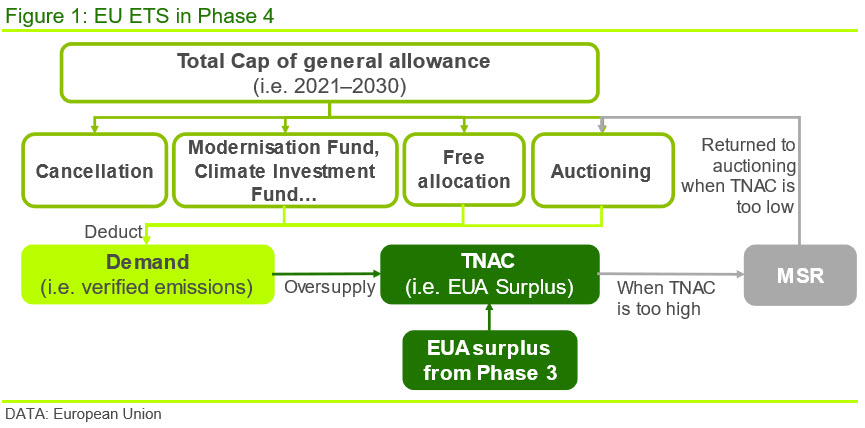
The EU wants to tighten the rules in Phase 4 of the ETS to increase carbon prices therefore to incentivise industries, such as steel, to accelerate their decarbonisation plans. However, it is recognised that higher carbon changes will disadvantage EU industries relative to their international peers. As such, the EU’s CBAM will charge an emissions levy on certain goods imported into the EU to ‘level the playing field’ such that imported goods face the same carbon costs as EU producers under the ETS.
The CBAM levy is calculated based on the carbon content of the product minus the free allocations given to the EU producers, using the carbon price. Under CBAM, free allocations for sectors in the EU ETS will be gradually phased out by applying a CBAM factor on top of preliminary free allocations.
European lawmakers will legislate on the revised ETS and CBAM over coming months
As part of the ‘Fit for 55’ package, in July 2021 the European Commission (EC) proposed a revision of ETS in Phase 4 and the establishment of CBAM. However, the EC can only propose legislation and it is the role of the European Parliament and the Council of the European Union to implement the legislation. The European Parliament and Council agreed on their respective negotiation positions over previous weeks and months, after several arguments and compromises among the institutions.
These agreements mark an important step in progressing the EU’s CBAM and ETS legislation. In the next stage, the European Parliament and the Council will enter the so-called ‘Trilogue’ negotiations to agree on the final legislation for the ETS revisions and CBAM.
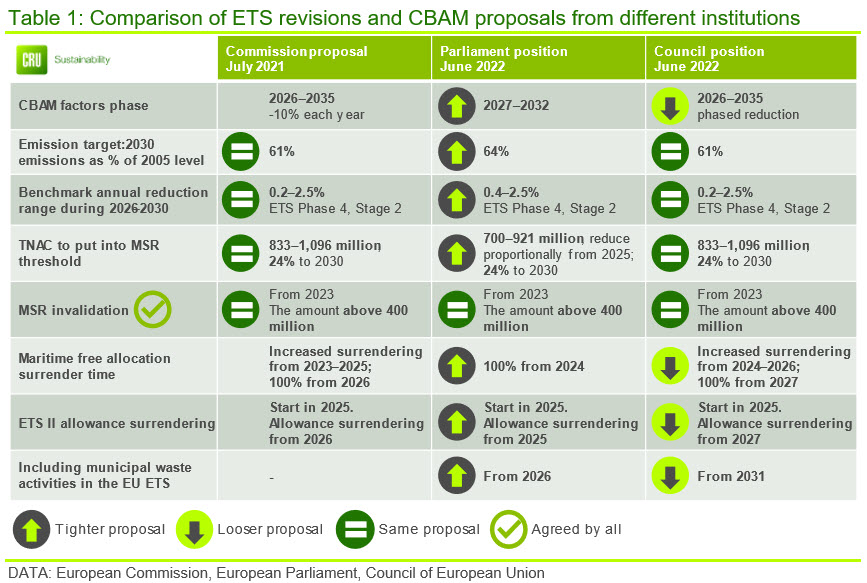
In aligning with the Paris Agreement to limit the increase in the global average temperature to 1.5 °C above pre-industrial levels, European lawmakers want to reduce greenhouse gas emissions by at least 55% below 1990 levels by 2030. To achieve this target, they agreed to the following measures in principle:
Creating a level playing field through CBAM
- Importers that have goods falling under the CBAM will need to start reporting the carbon content of their imports from 2023 onwards on a quarterly basis. This will be followed by a transitional period during which free allowances to sectors falling under CBAM will be gradually reduced until there are no free allowances left.
- Over the transitional period, importers will have to start purchasing carbon certificates corresponding to the carbon price faced by EU producers. At the end of the transition period, EU and non-EU producers should face the same carbon costs of production. The endpoint of this transition period has not been set yet.
A faster reduction of emission allowances
- The total amount of EUAs issued each year will be reduced to achieve at least 61% emission reduction by 2030 from the 2005 level. (See Table 1)
- Free allocation to installations covered by the EU ETS should be reduced from 2026 onwards with a modified product benchmark value.
- Each year, the allowances in the MSR exceeding 400 million will be invalidated to remove the oversupply of EUA.
More sectors and activities to be covered by the ETS
- The EU ETS will be expanded to cover the maritime transport sector and potentially other sectors.
- A new ETS system (‘ETS II’) specifically for buildings and road transport will be launched in 2025 to complement the existing EU ETS. This aims at an emissions reduction of 43% by 2030 compared to the 2005 level. The EU will assess the possibility of merging ETS II into the existing EU ETS at the end of the decade.
The details of the final legislation will need to be negotiated now. The European Parliament’s position is more ambitious than that originally proposed by the EC, while the Council’s position is more aligned to the EC’s proposals (Table 1). Against the backdrop of rapidly rising consumer prices, EU ministers cited concerns about the carbon cost burden of the ETS during the Council debate. To lessen the near-term impact of ETS changes, the Council proposed a slower phase out of the free allocation for CBAM sectors in the initial years of the scheme. The Council also proposed to delay by one year the launch of the new emission trading scheme. Figure 2 summarises the timeline of revised ETS and CBAM timeframe.
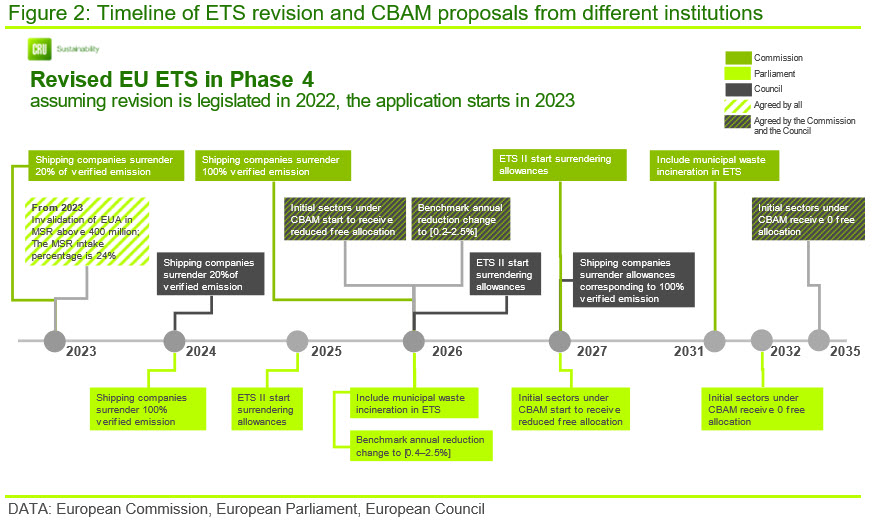
From policies to implementation: Capped, reduced and wiped out
While the final legislation still needs to be drafted, the direction of travel is clear: despite the ongoing war in Ukraine, European lawmakers are determined to cut emissions and lift the carbon price levels. Businesses ought to start preparing for these huge changes now.
The total number of emission allowances (i.e. the Cap) will be reduced to ~50% of the 2021 level by 2030. During the CBAM transitional period, the amount of available free allocations will be reduced to ~40% of the 2021 level by 2030 (See Figure 3 below).
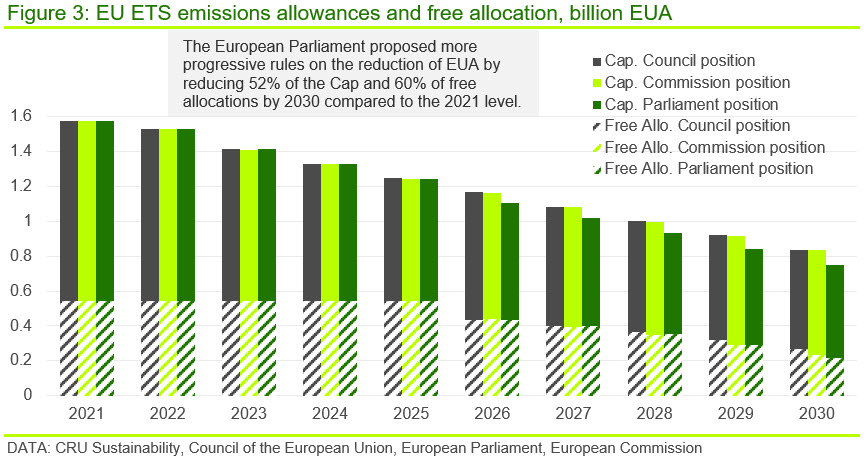
European lawmakers also agree that the MSR will need new rules. The MSR was set up in 2019 to absorb the oversupply of EUA to support the carbon price and to smooth market fluctuations. Allowances could be transferred between the market and the MSR. In the new proposals, from 2023 onwards, the MSR will be limited to under 400 million EUAs through the invalidation mechanism.
These shared efforts will lead to the elimination of the TNAC surplus by 2025. From 2026 onwards ,each year’s emission allowances will cap EU emissions in that year, as there will be no additional EUA in the market to trade.
Industries will be burdened by a high carbon cost
Factoring in the ETS revision, CRU forecasts the EU carbon price to reach ~€120 /tCO₂ in 2025 and ~€150 /tCO2 by 2030 (Figure 4). Meanwhile, the CBAM levy will be increasingly charged at the carbon price level with reducing free allocation. It is clear that sectors, especially those under the CBAM, such as steel, aluminium and fertilizers, will face a huge increase in carbon costs in the future and, until the free allocation is removed completely, a cost disadvantage relative to importers.
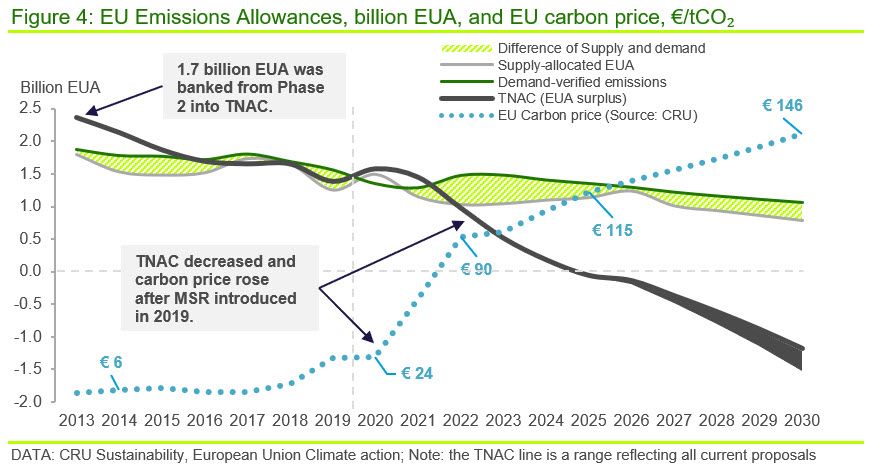
As an example, European BOF steelmakers currently receive ~80% of their EUA requirements through free allowances. Taking the average BOF emission intensity of ~2.0 tCO2/t crude steel produced, and today’s carbon price of ~€83 /tCO2, each tonne of BOF steel needs to pay €33.5 /t crude steel, 7% of today’s BOF cost. By 2030, only around one third of emissions will be covered by free allowances, resulting in a carbon cost in the range of €192 to €222 /t crude steel, ~40% of today’s BOF cost. The details of how the proposed ETS revisions will affect the steel industry will be further discussed in an upcoming insight.
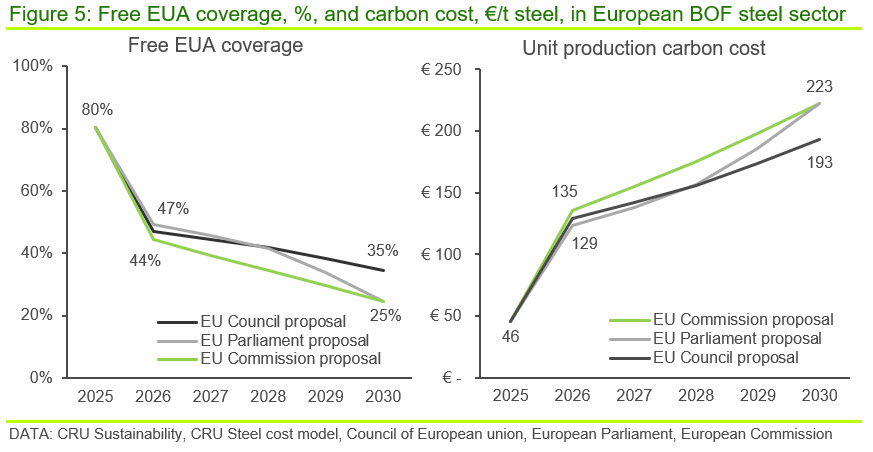
There is no time to wait for decarbonisation
Businesses need to understand the ramifications of the upcoming legislation. European policymakers are determined to reduce carbon emissions over the coming decade despite the recent energy crisis and geopolitical uncertainties. Based on the original EC proposals, the European Parliament and the Council have agreed on their respective positions on the revised ETS and CBAM in line with the Paris Agreement. However, the final details of the legislation are still in the negotiation phase.
In many sectors, the cost of decarbonisation is already high. However, the cost of carbon compliance within the EU will soon be lifted higher, as carbon prices increase and free allocations fall, and it will be more broadly applicable as more sectors are included. In the meantime, CBAM will be introduced to limit international carbon leakage, but this is unlikely to be a panacea and higher carbon costs will likely render EU a less favourable choice in global trades. To mitigate these risks as much as possible, industries in the EU will need to seek the means for decarbonisation and accelerate the green transition to limit their exposure to ever higher carbon prices.
Get in touch with us to find out more about the impact of CBAM and industries’ solutions in the green transition.
Find out more about our Sustainability Services.
Our reputation as an independent and impartial authority means you can rely on our data and insights to answer your big sustainability questions.
Tell me more





